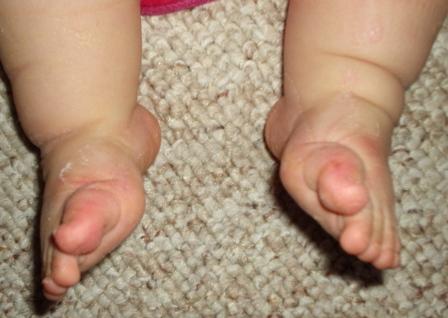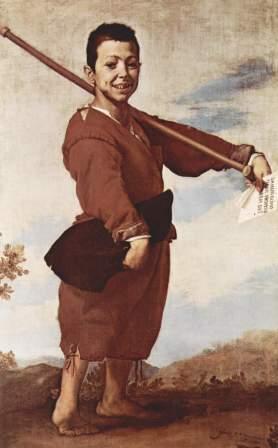Club foot
For patient information, click here
| Club foot | |
 | |
|---|---|
| Corrected clubfoot | |
| ICD-10 | M21.5, Q66.8 |
| ICD-9 | 736.71, 754.5-754.7 |
| OMIM | 119800 |
| DiseasesDB | 29395 |
| eMedicine | radio/177 orthoped/598 |
| MeSH | D003025 |
|
Club foot Microchapters |
|
Diagnosis |
|---|
|
Treatment |
|
Case Studies |
|
Club foot On the Web |
|
American Roentgen Ray Society Images of Club foot |
Editor-In-Chief: C. Michael Gibson, M.S., M.D. [2]
A clubfoot, or talipes equinovarus[1] (TEV), is a birth defect. The foot is twisted in (inverted) and down. Without treatment , persons afflicted often appear to walk on their ankles, or on the sides of their feet. It is a common birth defect, occurring in about one in every 1,000 live births. Approximately 50% of cases of clubfoot are bilateral. In most cases it is an isolated dysmelia. Incidence in males is higher than in females.
Causes
There are different causes for clubfoot: Mainly caused by Edwards' syndrome, a genetic defect with three copies of chromosome 18 genetic causes with incidence rates increasing significantly when multiple direct family members have the condition external influences such as intrauterine compression from oligohydramnios or from amniotic band syndrome. TEV may be associated with other birth defects such as spina bifida cystica. Use of MDMA (Ecstasy) while pregnant has been linked with this congenital abnormality.[2]
Treatments
Clubfoot is treated with manipulation largely by a podiatrist, sometimes an orthopedic surgeons, specialist nurses, or orthotists, will treat the condition by providing FAB braces to hold the feet in orthodox positions, serial casting, or small splints called knee ankle foot orthoses(KAFO). Other orthotic options include Denise-Brown bars with straight last boots, ankle foot orthoses (AFO) and/or custom foot orthoses (CFO). In North America, manipulation is followed by serial casting, most often by the Ponseti Method. Foot manipulations usually begin within two weeks of birth. Even with successful treatment, when only one side is affected, that foot may be smaller than the other, and often that calf, as well.
Extensive surgery of the soft tissue or bone is not usually necessary to treat clubfoot; however, there are two minimal surgeries that may be required: 1. Tenotomy (needed in 80% of cases) is a release (clipping) of the Achilles tendon - minor surgery- local anesthesia and 2. Anterior Tibial Tendon Transfer (needed in 20% of cases) - where the tendon is moved from the first ray (toe) to the third ray in order to release the inward traction on the foot. Of course, each case is different but the main idea is that extensive surgery is not needed to treat clubfoot. Extensive surgery may lead to scar tissue developing inside the child's foot. The scarring may result in functional, growth and aesthetic problems in the child's foot because the scarred tissue will interfere with the normal development of the foot. A child who has extensive surgery may require on average 2 additional surgeries to correct the issues presented above.
In stretching and casting therapy the doctor changes the cast multiple times over a few weeks, gradually stretching tendons until the foot is in the correct position of external rotation. The heel cord is released (percutaneous tenotomy) and another cast is put on, which is removed after three weeks. To avoid relapse a corrective brace is worn for a gradually reducing time until it is only at night up to four years of age.
Ponseti Method

The clubfoot treatment method that is becoming the standard in US and worldwide is known as the Ponseti Method [3]. Foot manipulations differ subtly from the Kite casting method which prevailed during the late 20th century. Although described by Dr. Ignacio Ponseti in the 1950s, it did not reach a wider audience until it was re-popularized by Dr. John Herzenberg in 2000 and by parents of children with clubfeet using the Internet [4]. The Ponseti method, if correctly done, is successful in >95% of cases [5] in correcting clubfeet using non- or minimal-surgical techniques. Typical clubfoot cases usually require 5 casts over 4 weeks. Atypical clubfeet and complex clubfeet may require a larger number of casts. Approximately 80% of infants require an Achilles tenotomy (microscopic incision in the tendon requiring only local anesthetic and no stitches) performed in a clinic toward the end of the serial casting.
After correction has been achieved, maintenance of correction may require the full-time (23 hours per day) use of a splint—also known as a foot abduction brace (FAB)—on both feet, regardless or whether the TEV is on one side or both, for several weeks after treatment. Part-time use of a brace (generally at night, usually 12 hours per day) is frequently prescribed for up to 4 years. Approximately 20% of infants successfully treated with the Ponseti casting method may require a surgical tendon transfer after two years of age. While this requires a general anesthetic, it is a relatively minor surgery that corrects a persistent muscle imbalance while avoiding disturbance to the joints of the foot.
The developer of the Ponseti Method, Dr Ignacio Ponseti, at 93 years of age is still treating children with clubfeet (including complex/atypical clubfeet and failed treatment clubfeet) at the University of Iowa Hospitals and Clinics. He is assisted by Dr Jose Morcuende, president of the Ponseti International Association.
The long-term outlook [6] for children who experienced the Ponseti Method treatment is comparable to that of non-affected children.
Watch a Video on the Ponseti Method
Famous people

Many notable people have been born with club foot, including the Roman emperor Claudius, the poet Lord Byron, statesman Prince Talleyrand, Civil War politician Thaddeus Stevens, the comedian Damon Wayans, actors Gary Burghoff and Dudley Moore, footballer Steven Gerrard, and film director David Lynch.
Kristi Yamaguchi was reportedly born with a club foot, and went on to win figure skating gold in 1992. Soccer star Mia Hamm was born with the condition. Baseball pitcher Larry Sherry was born with club feet, as was pitcher Jim Mecir, and both enjoyed long and successful careers. Pittsburgh Pirates infielder Freddy Sanchez cites his ability to overcome the defect as a reason for his success [7].
Dallas Cowboys quarterback Troy Aikman also overcame the condition en route to a Pro Football Hall of Fame career.
Josef Goebbels, the notorious Nazi propaganda minister, had a right club foot (possibly incurred after birth as a complication of osteomyelitis)[8], a fact hidden from the German public by censorship. Because of this malformation, Goebbels needed to wear a leg brace. That, plus his short stature, led to his rejection for military service in World War I.
In literature
The main character, Philip Carey, in W. Somerset Maugham's novel Of Human Bondage, has a club foot, a central theme in the work.
Hippolyte Tautain, the stable man at the Lion D'Or public house in Gustave Flaubert's novel Madame Bovary is unsuccessfully treated for clubfoot by Charles Bovary, leading to the eventual amputation of his leg.
Charlie Wilcox, the main character in the novel Charlie Wilcox by Sharon McKay had a club foot.
In Yukio Mishima's seminal novel The Temple of the Golden Pavilion the character Kashiwagi has club feet which parallels the stutter of the main character, Mizoguchi.
In the Mallorean, Senji the sorcerer has a club foot.
In Caroline Lawrence's Roman Mysteries series, a character called Vulcan the blacksmith appears in the book "The Secrets of Vesuvius". He reveals that he gained the nickname because of his club foot.
External links
- Ponseti International site for Parents
- Ponseti International site for health care providers
- Steps Charity Worldwide
- Dr. Ponseti's website
- Clubfoot Fact Sheet (March of Dimes)
- South African website with information about clubfoot for parents
- ClubFeet.net, Information and advice on ClubFeet
- Clubfootclub.org
- Clubfoot.co.uk
- The Rubin Institute for Advanced Orthopedics at Sinai Hospital
References
- ↑ The term talipes is from Latin talus, ankle + pes, foot. Equino-, of or resembling a horse and -varus, turned inward.
- ↑ {{McElhatton PR, Bateman DN, Evans C, Pughe KR, Thomas SH (1999). "Congenital anomalies after prenatal ecstasy exposure". Lancet. 354 (9188): 1441–2. PMID 10543673.
- ↑ To Parents of Children Born with Clubfeet: Orthopaedics: UI Health Topics
- ↑ nosurgery4clubfoot : nosurgery4clubfoot
- ↑ Radical Reduction in the Rate of Extensive Corrective Surgery for Clubfoot Using the Ponseti Method - Morcuende et al. 113 (2): 376 - Pediatrics
- ↑ [1]
- ↑ Freddy or not, here comes last leg of batting race
- ↑ Goebbels is commonly said to have had club foot (talipes equinovarus), a congenital condition. But William L. Shirer, who spent the 1930s in Berlin as a journalist and was acquainted with Goebbels, wrote in The Rise and Fall of the Third Reich (Simon and Schuster 1960) that the deformity arose from a childhood attack of osteomyelitis and a botched operation to correct it. Osteomyelitis, an infection within the bone marrow, can cause the destruction of one or more of the growing points in the long bones of the leg, a condition known as septic osteoblastic dysgenesis. This will result in a shortened leg.
Template:Diseases of the musculoskeletal system and connective tissue
de:Klumpfuß it:Piede equino nl:Klompvoet fi:Kampurajalka sv:Klumpfot